供应链下的多级存货管理【外文翻译】
供应链VMI模式下的库存管理优化
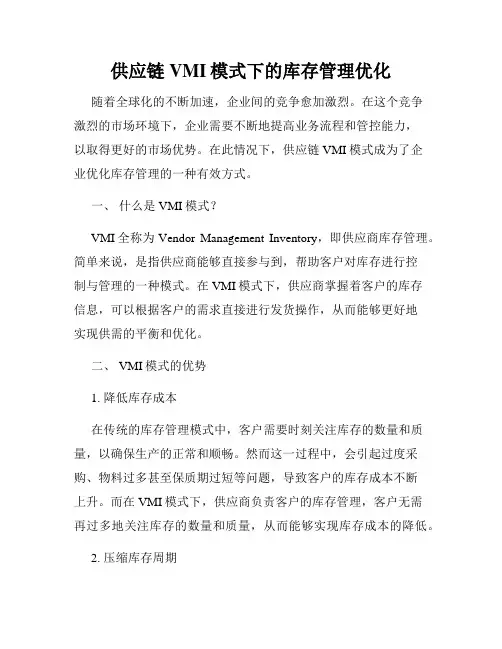
供应链VMI模式下的库存管理优化随着全球化的不断加速,企业间的竞争愈加激烈。
在这个竞争激烈的市场环境下,企业需要不断地提高业务流程和管控能力,以取得更好的市场优势。
在此情况下,供应链VMI模式成为了企业优化库存管理的一种有效方式。
一、什么是VMI模式?VMI全称为Vendor Management Inventory,即供应商库存管理。
简单来说,是指供应商能够直接参与到,帮助客户对库存进行控制与管理的一种模式。
在VMI模式下,供应商掌握着客户的库存信息,可以根据客户的需求直接进行发货操作,从而能够更好地实现供需的平衡和优化。
二、 VMI模式的优势1. 降低库存成本在传统的库存管理模式中,客户需要时刻关注库存的数量和质量,以确保生产的正常和顺畅。
然而这一过程中,会引起过度采购、物料过多甚至保质期过短等问题,导致客户的库存成本不断上升。
而在VMI模式下,供应商负责客户的库存管理,客户无需再过多地关注库存的数量和质量,从而能够实现库存成本的降低。
2. 压缩库存周期在传统的库存管理体系中,客户需提前预定所需物料,供应商再进行生产、发货等操作后,才能将物料到达客户仓库。
这一过程需要较长的时间,会大大延长库存周期。
而在VMI模式下,供应商了解客户需求后,可以依据当时实际库存情况,立刻为客户发货,从而将库存周期大幅压缩。
3. 提高企业竞争力库存管理与采购效率直接关系到企业生产效率和竞争力。
随着供应链VMI模式不断提高工业运作的效率和生产的灵活性,更加适应市场变化。
在供应链VMI模式下,企业可以实现快速响应市场需求,提高管理水平和生产效率,从而为企业带来更多的竞争优势。
三、基于VMI模式下的库存管理优化在VMI模式下,库存管理的重点在于供应商和客户之间的合作。
针对不同的采购需求和库存料号等问题,可以采取以下具体措施实现库存优化:1. 合理分析产品分类针对已有产品,可以根据分类规则与标准制定一份产品分类表,将现有库存品种归类,并按照供应商和客户之间的物料需求比例分配库存物料,从而优化库存管理。
《 供应商管理库存和联合库存管理多级库存管理(PPT 32页) 》
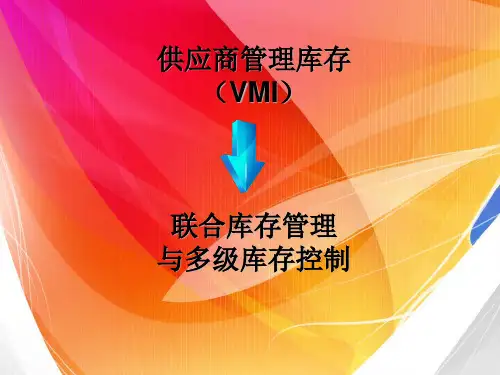
• 库存作为供需双方的信息交流和协调的纽 带,可以暴露供应链管理中的缺陷,为改 进供应链管理水平提供依据。
• 为实现零库存管理、准时采购以及精细供 应链管理创造了条件。
的渠道,时间间隔等; 11. 付款条款的拟订,包括付款方式,有关文件准备等; 12. 罚款条约的拟订,例如供应商装错了货物或装了空箱,他
将承担哪些额外的费用;如果用户提供了不充分或另人误 解的信息导致供应商出错,有关损失费用如何分摊;如果 用户取消了产品而因为信息渠道或其他原因供应商已经送 货,谁将对这批存货负责等。
四、实施VMI、IS等新策略的要 点
• 分析传统的库存管理——RMI,即零售商(需求方) 管理的库存——的弊端
1. 要控制库存资源 2. 导致与现代市场竞争环境的不适应性
• 供应商管理的库存——VMI
1. 由供应商监控库存变化 2. 信息高度共享和开放 3. 双方的信任 4. 共同降低成本、提高赢利水平
VMI全称Vendor Managed Inventory, 即供应商管理库存。它是一种在供应链环 境下的库存运作模式,本质上,它是将多 级供应链问题变成单级库存管理问题,相 对于按照传统用户发出订单进行补货的传 统做法。VMI是以实际或预测的消费需求 和库存量,作为市场需求预测和库存补货 的解决方法,即由销售资料得到消费需求 信息,供货商可以更有效的计划、更快速 的反应市场变化和消费需求。
3. 供应商使用什么样的工具交货,在哪里建立仓库,其 面积能否保证产品的进出和不断增长的产品需求;
4. 谁将代表供应商管理存货,其管理能力、声誉、业务 范围和过去的经验、财务状况、人力资源等需要达到 什么标准?
供应商管理库存规划(英文版).pptx
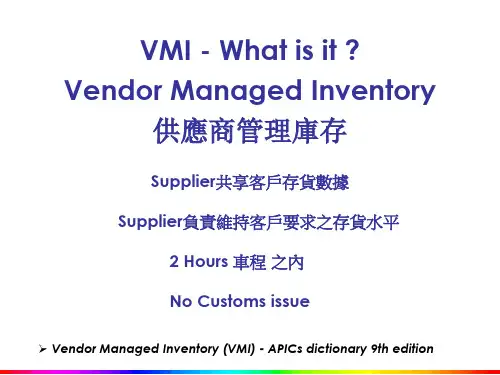
• Consolidate the physical flow through the HUB • Increase Supply Chain visibility • Increase Manageability : standard process across BUs • Optimize demand/supply management
傳統產銷模式
物料
Suppliers
TIO
存貨 非保稅 factories
Accessories & Monitors
TIO
存貨
Resellers & Customers
物料
TIO
存貨 保稅 factories
VMI 產 銷 模 式
Suppliers
Accessories 物料 & Monitors 物料
• Hub:
– 對供應商的表現每月作出評報 , Hub Down 或者 ETA 可信度 – 每月提供庫存變動給供應商和FOXCONN .
–GS P: – 平衡過去 performance data within evaluation process – 必要時進行強制手段.
•Supplier:
– 維護供應商Scoreboard , 及時溝通並找出解決方式.
• GSP:
– 選擇最好的供應商. – 平衡各事業處需求. – 與BUs 合作制定相應的供應鏈模式. – 制定FOXCONN / 供應商合同. – 為供應商和BUs 提供溝通的機會. – 為Hub 提供一些標準給供應商 , 如棧板規格限制等. – 通過溝通或Ts&Cs 訊流及時更新數據. – 管理責任:
供应链管理—多级库存优化管理
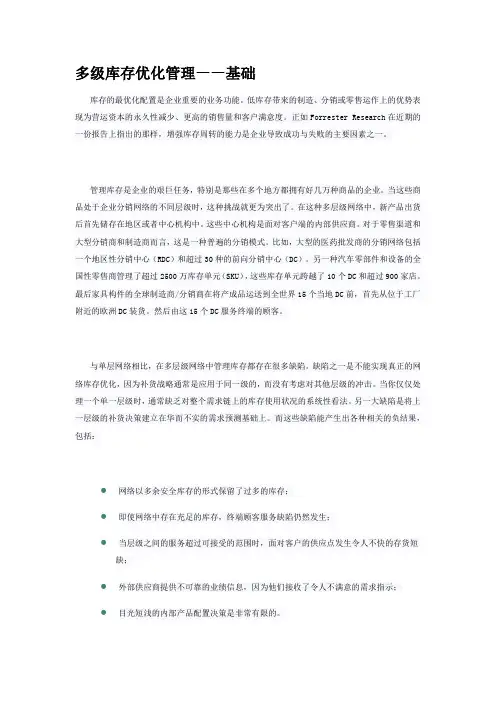
多级库存优化管理——基础库存的最优化配置是企业重要的业务功能。
低库存带来的制造、分销或零售运作上的优势表现为营运资本的永久性减少、更高的销售量和客户满意度。
正如Forrester Research在近期的一份报告上指出的那样,增强库存周转的能力是企业导致成功与失败的主要因素之一。
管理库存是企业的艰巨任务,特别是那些在多个地方都拥有好几万种商品的企业。
当这些商品处于企业分销网络的不同层级时,这种挑战就更为突出了。
在这种多层级网络中,新产品出货后首先储存在地区或者中心机构中。
这些中心机构是面对客户端的内部供应商。
对于零售渠道和大型分销商和制造商而言,这是一种普遍的分销模式。
比如,大型的医药批发商的分销网络包括一个地区性分销中心(RDC)和超过30种的前向分销中心(DC)。
另一种汽车零部件和设备的全国性零售商管理了超过2500万库存单元(SKU),这些库存单元跨越了10个DC和超过900家店。
最后家具构件的全球制造商/分销商在将产成品运送到全世界15个当地DC前,首先从位于工厂附近的欧洲DC装货。
然后由这15个DC服务终端的顾客。
与单层网络相比,在多层级网络中管理库存都存在很多缺陷。
缺陷之一是不能实现真正的网络库存优化,因为补货战略通常是应用于同一级的,而没有考虑对其他层级的冲击。
当你仅仅处理一个单一层级时,通常缺乏对整个需求链上的库存使用状况的系统性看法。
另一大缺陷是将上一层级的补货决策建立在华而不实的需求预测基础上。
而这些缺陷能产生出各种相关的负结果,包括:●网络以多余安全库存的形式保留了过多的库存;●即使网络中存在充足的库存,终端顾客服务缺陷仍然发生;●当层级之间的服务超过可接受的范围时,面对客户的供应点发生令人不快的存货短缺;●外部供应商提供不可靠的业绩信息,因为他们接收了令人不满意的需求指示;●目光短浅的内部产品配置决策是非常有限的。
本文将会考察解决多级网络中管理库存问题的两种可供选择的方法,此外,文章也会提出在满足所有客户服务目标的同时,最小化各层级库存的最佳方法。
外文翻译--- 供应链管理下的库存控制
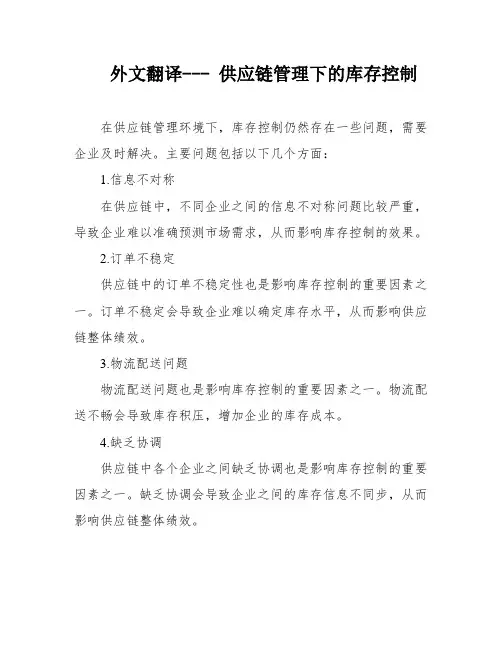
外文翻译--- 供应链管理下的库存控制在供应链管理环境下,库存控制仍然存在一些问题,需要企业及时解决。
主要问题包括以下几个方面:1.信息不对称在供应链中,不同企业之间的信息不对称问题比较严重,导致企业难以准确预测市场需求,从而影响库存控制的效果。
2.订单不稳定供应链中的订单不稳定性也是影响库存控制的重要因素之一。
订单不稳定会导致企业难以确定库存水平,从而影响供应链整体绩效。
3.物流配送问题物流配送问题也是影响库存控制的重要因素之一。
物流配送不畅会导致库存积压,增加企业的库存成本。
4.缺乏协调供应链中各个企业之间缺乏协调也是影响库存控制的重要因素之一。
缺乏协调会导致企业之间的库存信息不同步,从而影响供应链整体绩效。
为了解决这些问题,企业需要采取一系列措施,如加强信息共享、优化订单管理、完善物流配送体系、建立协调机制等,以提高供应链整体绩效和库存控制的效果。
尽管从宏观角度来看,供应链管理环境下的库存控制比传统管理更具优势,但实际操作中,由于每个企业对供应链管理的理解存在差异,存在利益冲突等问题,导致实际运用时也会出现许多问题。
其中,主要存在以下几个方面的问题:1.各企业缺乏供应链管理的整体观念,导致各自为政的行为降低了供应链整体效率。
2.交货状态数据不准确,导致客户不满和供应链中某些企业增加库存量。
3.信息传递系统低效率,导致延迟和不准确的信息,影响库存量的精确度和短期生产计划的实施。
4.缺乏合作与协调性,组织障碍是库存增加的一个重要因素。
5.产品的过程设计没有考虑供应链上库存的影响,导致成本效益被库存成本抵消,引进新产品时也会遇到问题。
因此,在供应链管理环境下,需要制定合适的库存控制策略,包括建立整体观念,提高信息传递效率,加强合作与协调性,考虑库存影响的产品设计等措施,以提高供应链整体效率。
针对库存管理问题,我们推出以下策略:1.供应商管理库存策略:VMI(Vendor Managed Inventory)库存管理模式。
供应链环境下库存管理研究综述(精)
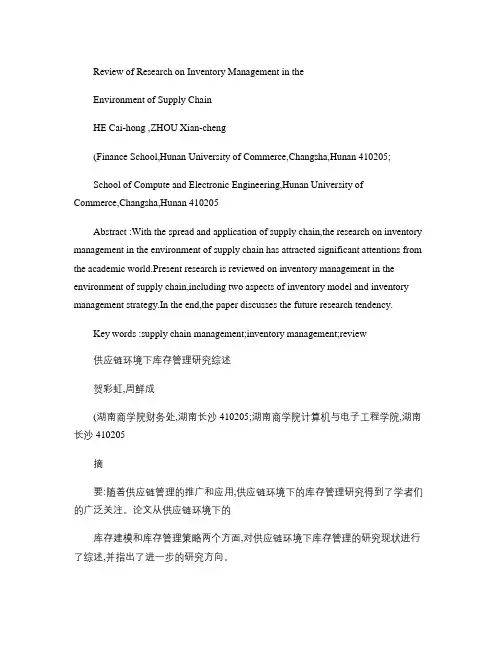
Review of Research on Inventory Management in theEnvironment of Supply ChainHE Cai-hong ,ZHOU Xian-cheng(Finance School,Hunan University of Commerce,Changsha,Hunan 410205;School of Compute and Electronic Engineering,Hunan University of Commerce,Changsha,Hunan 410205Abstract :With the spread and application of supply chain,the research on inventory management in the environment of supply chain has attracted significant attentions from the academic world.Present research is reviewed on inventory management in the environment of supply chain,including two aspects of inventory model and inventory management strategy.In the end,the paper discusses the future research tendency.Key words :supply chain management;inventory management;review供应链环境下库存管理研究综述贺彩虹,周鲜成(湖南商学院财务处,湖南长沙410205;湖南商学院计算机与电子工程学院,湖南长沙410205摘要:随着供应链管理的推广和应用,供应链环境下的库存管理研究得到了学者们的广泛关注。
供应商管理库存和联合库存管理多级库存管理
•
好的事情马上就会到来,一切都是最 好的安 排。下 午2时17分29秒 下午2时17分14:17:2920.10.27
•
一马当先,全员举绩,梅开二度,业 绩保底 。20.10.2720.10.2714:1714:17:2914:17:29Oc t-20
•
牢记安全之责,善谋安全之策,力务 安全之 实。2020年10月27日 星期二2时17分 29秒T uesday, October 27, 2020
的合作框架协议。 第四、组织机构的变革。
基本步骤
• 进行基于活动的成本分 析(activity-based costing, 简称ABC)
• 组建多功能小组
1. 供应链中企业的仓储人员可能认为VMI对他们在企业 中的地位是一种威胁,必须做好他们的工作以保证有 效地实施VMI。
2. 拟定一份粗略的存货品种和补充计划,讨论VMI包含 哪些存货品种,开始应该管理多少产品,何时增加新 产品;
零售商成本中心 成本
Dt=∑dt 优化
控制策略
(三)基于时间优化的多级库存控制
– 在供应链管理环境下,库存优化还应该考虑对 时间的优化,比如库存周转率的优化、供应提 前期优化、平均上市时间的优化等。库存时间 过长对于产品的竞争力不利,因此供应链系统 应从提高用户响应速度的角度提高供应链的库 存管理水平。
•
踏实肯干,努力奋斗。2020年10月27日下午2时17分 20.10.2720.10.27
•
追求至善凭技术开拓市场,凭管理增 创效益 ,凭服 务树立 形象。2020年10月27日星期 二下午2时17分 29秒14:17:2920.10.27
•
按章操作莫乱改,合理建议提出来。2020年10月下 午2时17分20.10.2714:17October 27, 2020
外文翻译---供应链管理ABC
毕业设计(论文)外文资料翻译外文出处:The ABCs of Supply Chain (用外文写)Management附件:1.外文资料翻译译文;2.外文原文。
附件1:外文资料翻译译文供应链管理ABC1.什么是供应链管理供应链是一种关于整合的科学和艺术,它主要探究提高企业采购生产商品所需的原材料、生产商品,并把它供应给最终顾客的效率的途径。
以下是供应链管理的五个基本组成模块:计划--它是供应链的战略层面。
企业需要有一个控制所有资源的战略以满足客户对产品或服务的需求。
计划的核心是建立一套机制去监控整条供应链以便使它能有效运作:低成本、高品质配送和增值客户服务。
该模块连结着供应链的作业与营运目标,主要包括需求/供给规划(Demand/Supply Planning)与规划基础建设(infrastructure)两项活动,对所有采购运筹流程、制造运筹流程与配送运筹流程进行规划与控制。
需求/供给规划活动包含了评估企业整体产能与资源、总体需求规划以及针对产品与配销管道,进行存货规划、配送规划、制造规划、物料及产能的规划。
规划基础建设管理包含了自制或外包决策的制定、供应链的架构设计、长期产能与资源规划、企业规划、产品生命周期的决定、新旧产品线规划与产品线的管理等。
采购—选择供给你提供用来生产产品或服务的原材料或服务的供应商。
和供应商建立一套价格、供应、支付过程的体系,创造一种机制以监控此过程、改善供应商关系。
理顺此过程以管理供应商交付的原材料库存或服务,其中包括收货、出货、检验、中转和批准支付。
此模块有采购作业与采购基础建设两项管理活动,其目的是描述一般的采购作业与采购管理流程。
采购作业包含了寻找供货商、收料、进料品检、拒收与发料作业。
采购基础建设的管理包含了供货商评估、采购、运输管理、采购品质管理、采购合约管理、付款条件管理、采购零组件的规格制定。
制造—这是制造步骤。
计划这些必需的活动:生产、测试、包装、预出货。
基于供应链环境的多级库存优化管理研究
基于供应链环境的多级库存优化管理研究基于供应链环境的多级库存优化管理研究1. 引言随着全球化经济的发展和供应链管理的日益重要,多级库存管理在现代供应链中扮演着至关重要的角色。
随着市场竞争加剧,企业需要寻求有效的库存管理方法来降低库存成本,提高客户满意度,并确保供应链的可靠性和灵活性。
因此,本文将研究基于供应链环境的多级库存优化管理,旨在提供有效的库存管理策略,以满足供需平衡和经济效益的要求。
2. 多级库存的定义和特点多级库存是指在供应链中各级节点上的库存,这些节点包括供应商、生产商、分销商和最终客户等。
多级库存的管理涉及到从供应链的源头到终端,以及供应链内部的库存转移和协同。
多级库存管理具有以下特点:首先,在供应链中的每个节点上都存在库存,这些节点之间的关系和交互会对库存管理产生影响。
因此,多级库存管理需要考虑不同节点之间的信息传递、协作和协调。
其次,多级库存管理需要解决不同节点之间的信息不对称和延迟的问题。
供应链中的每个节点都有不同的库存需求和预测,但这些信息通常存在不确定性和时滞性。
因此,多级库存管理需要考虑如何准确地收集、分析和利用节点之间的信息,以实现优化的库存管理。
最后,供应链中的多级库存管理需要考虑不同节点之间的协同和协调。
在实际情况下,供应链中的库存决策往往是分散的,各个节点往往只看到局部的库存需求和预测。
因此,多级库存管理需要确保不同节点之间的协同和协调,以实现整体的供需平衡和经济效益。
3. 多级库存优化的挑战实现基于供应链环境的多级库存优化管理面临着许多挑战,包括库存需求的不确定性、供应链节点之间的信息流通和协调以及库存管理策略的决策问题等。
首先,库存需求的不确定性是多级库存优化管理的主要挑战之一。
供应链中的库存需求受到市场需求、产品周期和季节性等因素的影响,这些因素往往难以准确预测。
因此,如何处理库存需求的不确定性,实现供需平衡和库存成本的最优化是多级库存优化管理的重要问题。
供应链管理中的库存控制--ambivalent
9
库存的ABC分类
按实际使用成本进行分类(20/80原则)
数量
2019/11/23
5-15%
A
60-80%
C
20-30%
B
深圳市博维企业管理咨询有限公司
物料种类
10
库存的ABC分类
在ABC分类基础上的库存管理策略:
1. 花费在A类库存的资金应大大多于花费在C类库存上 的资金。 2. 对A类库存的管理应更严格,它们应存放在更安全的 地方,而且为了保证它们的记录准确性,应对它们更频 繁地进行盘点。 3. A类物料的计划与采购应比B、C类物料更为严格。
2019/11/23
深圳市博维企业管理咨询有限公司
5
库存是浪费? 库存是必要的储备?
库存是企业生产运作及供应链管理全过程的
“无缝连接器”!
2019/11/23
深圳市博维企业管理咨询有限公司
6
不合理的库存管理曾使许多国际大公司 陷入困境:
-- 诺基亚(NOKIA) -- 戴尔电脑 (DELL) -- 国际商用机器 (IBM) -- 思科(CISCO) -- 爱立信
16
2. 集中策略和分散策略
安全库存:集中库存同时也集中了风险,库存越集中,抵 御缺货风险能力越强,安全库存水平越低。
提前期:集中库存的提前期长,库存分散使库存更加靠近 需求点。
管理费用:集中仓库所需的管理费用低于分散仓库管理费 用。
运输成本和客户服务水平:仓库越多,运输总距离长,成 本越高,但由于接近客户点,送货成本会降低,客户满意 度也较高。
染色 Dyeing
50
深圳市博维企业管理咨询有限公司
22
补充:VMI库存管理方法
- 1、下载文档前请自行甄别文档内容的完整性,平台不提供额外的编辑、内容补充、找答案等附加服务。
- 2、"仅部分预览"的文档,不可在线预览部分如存在完整性等问题,可反馈申请退款(可完整预览的文档不适用该条件!)。
- 3、如文档侵犯您的权益,请联系客服反馈,我们会尽快为您处理(人工客服工作时间:9:00-18:30)。
本科毕业论文(设计)外文翻译原文:Multi-echelon inventory management in supply chains Historically, the echelons of the supply chain, warehouse, distributors, retailers, etc., have been managed independently, buffered by large inventories. Increasing competitive pressures and market globalization are forcing firms to develop supply chains that can quickly respond to customer needs. To remain competitive and decrease inventory, these firms must use multi-echelon inventory management interactively, while reducing operating costs and improving customer service.Supply chain management (SCM) is an integrative approach for planning and control of materials and information flows with suppliers and customers, as well as between different functions within a company. This area has drawn considerable attention in recent years and is seen as a tool that provides competitive power .SCM is a set of approaches to integrate suppliers, manufacturers, warehouses, and stores efficiently, so that merchandise is produced and distributed at right quantities, to the right locations and at the right time, in order to minimize system-wide costs while satisfying service-level requirements .So the supply chain consists of various members or stages. A supply chain is a dynamic, stochastic, and complex system that might involve hundreds of participants.Inventory usually represents from 20 to 60 per cent of the total assets of manufacturing firms. Therefore, inventory management policies prove critical in determining the profit of such firms. Inventory management is, to a greater extent, relevant when a whole supply chain (SC), namely a network of procurement, transformation, and delivering firms, is considered. Inventory management is indeed a major issue in SCM, i.e. an approach that addresses SC issues under an integrated perspective.Inventories exist throughout the SC in various forms for various reasons. Thelack of a coordinated inventory management throughout the SC often causes the bullwhip effect, namely an amplification of demand variability moving towards the upstream stages. This causes excessive inventory investments, lost revenues, misguided capacity plans, ineffective transportation, missed production schedules,and poor customer service.Many scholars have studied these problems, as well as emphasized the need of integration among SC stages, to make the chain effectively and efficiently satisfy customer requests (e.g. reference). Beside the integration issue, uncertainty has to be dealt with in order to define an effective SC inventory policy. In addition to the uncertainty on supply (e.g. lead times) and demand, information delays associated with the manufacturing and distribution processes characterize SCs.Inventory management in multi-echelon SCs is an important issue, because thereare many elements that have to coordinate with each other. They must also arrangetheir inventories to coordinate. There are many factors that complicate successful inventory management, e.g. uncertain demands, lead times, production times, product prices, costs, etc., especially the uncertainty in demand and lead times where the inventory cannot be managed between echelons optimally.Most manufacturing enterprises are organized into networks of manufacturingand distribution sites that procure raw material, process them into finished goods, and distribute the finish goods to customers. The terms ‘multi-echelon’ or ‘multilevel‘production/distribution networks are also synonymous with such networks(or SC), when an item moves through more than one step before reaching the final customer. Inventories exist throughout the SC in various forms for various reasons. Atany manufacturing point, they may exist as raw materials, work in progress, or finished goods. They exist at the distribution warehouses, and they exist in-transit, or‘in the pipeline’, on each path linking these facilities.Manufacturers procure raw material from suppliers and process them into finished goods, sell the finished goods to distributors, and then to retail and/or customers. When an item moves through more than one stage before reaching thefinal customer, it forms a ‘multi-echelon’ inventory system. The echelon stock of a stock point equals all stock at this stock point, plus in-transit to or on-hand at any of its downstream stock points, minus the backorders at its downstream stock points.The analysis of multi-echelon inventory systems that pervades the business world has a long history. Multi-echelon inventory systems are widely employed to distribute products to customers over extensive geographical areas. Given the importance of these systems, many researchers have studied their operating characteristics under a variety of conditions and assumptions. Since the development of the economic order quantity (EOQ) formula by Harris (1913), researchers and practitioners have been actively concerned with the analysis and modeling of inventory systems under different operating parameters and modeling assumptions .Research on multi-echelon inventory models has gained importance over the last decade mainly because integrated control of SCs consisting of several processing and distribution stages has become feasible through modern information technology. Clark and Scarf were the first to study the two-echelon inventory model. They proved the optimality of a base-stock policy for the pure-serial inventory system and developed an efficient decomposing method to compute the optimal base-stock ordering policy. Bessler and Veinott extended the Clark and Scarf model to include general arbores cent structures. The depot-warehouse problem described above was addressed by Eppen and Schrage who analyzed a model with a stockless central depot. They derived a closed-form expression for the order-up-to-level under the equal fractile allocation assumption. Several authors have also considered this problem in various forms. Owing to the complexity and intractability of the multi-echelon problem Hadley and Whitin recommend the adoption of single-location, single-echelon models for the inventory systems.Sherbrooke considered an ordering policy of a two-echelon model for warehouse and retailer. It is assumed that stock outs at the retailers are completely backlogged. Also, Sherbrooke constructed the METRIC (multi-echelon technique for coverable item control) model, which identifies the stock levels that minimize the expected number of backorders at the lower-echelon subject to a bud get constraint. This modelis the first multi-echelon inventory model for managing the inventory of service parts. Thereafter, a large set of models which generally seek to identify optimal lot sizes and safety stocks in a multi-echelon framework, were produced by many researchers. In addition to analytical models, simulation models have also been developed to capture the complex interaction of the multi-echelon inventory problems.So far literature has devoted major attention to the forecasting of lumpy demand, and to the development of stock policies for multi-echelon SCs Inventory control policy for multi-echelon system with stochastic demand has been a widely researched area. More recent papers have been covered by Silver and Pyke. The advantage of centralized planning, available in periodic review policies, can be obtained in continuous review policies, by defining the reorder levels of different stages, in terms of echelon stock rather than installation stock.Rau et al. , Diks and de Kok , Dong and Lee ,Mitra and Chatterjee , Hariga , Chen ,Axsater and Zhang , Nozick and Turnquist ,and So and Zheng use a mathematic modeling technique in their studies to manage multi-echelon inventory in SCs. Diks and de Kok’s study considers a divergent multi-echelon inventory system, such as a distribution system or a production system, and assumes that the order arrives after a fixed lead time. Hariga, presents a stochastic model for a single-period production system composed of several assembly/processing and storage facilities in series. Chen, Axsater and Zhang, and Nozick and Turnquist consider a two-stage inventory system in their papers. Axsater and Zhang and Nozickand Turnquist assume that the retailers face stationary and independent Poisson demand. Mitra and Chatterjee examine De Bodt and Graves’ model (1985), which they developed in their paper’ Continuous-review policies for a multi-echelon inventory problem with stochastic demand’, for fast-moving items from the implementation point of view. The proposed modification of the model can be extended to multi-stage serial and two -echelon assembly systems. In Rau et al.’s model, shortage is not allowed, lead time is assumed to be negligible, and demand rate and production rate is deterministic and constant. So and Zheng used an analytical model to analyze two important factors that can contribute to the high degree of order-quantity variability experienced bysemiconductor manufacturers: supplier’s lead time and forecast demand updating. They assume that the external demands faced by there tailor are correlated between two successive time periods and that the retailer uses the latest demand information to update its future demand forecasts. Furthermore, they assume that the supplier’s delivery lead times are variable and are affected by the retailer’s order quantities. Dong and Lee’s paper revisits the serial multi-echelon inventory system of Clark and Scarf and develops three key results. First, they provide a simple lower-bound approximation to the optimal echelon inventory levels and an upper bound to the total system cost for the basic model of Clark and Scarf. Second, they show that the structure of the optimal stocking policy of Clark and Scarf holds under time-correlated demand processing using a Martingale model of forecast evolution. Third, they extend the approximation to the time-correlated demand process and study, in particular for an autoregressive demand model, the impact of lead times, and autocorrelation on the performance of the serial inventory system.After reviewing the literature about multi-echelon inventory management in SCs using mathematic modeling technique, it can be said that, in summary, these papers consider two, three, or N-echelon systems with stochastic or deterministic demand. They assume lead times to be fixed, zero, constant, deterministic, or negligible. They gain exact or approximate solutions.Dekker et al. analyses the effect of the break-quantity rule on the inventory costs. The break-quantity rule is to deliver large orders from the warehouse, and small orders from the nearest retailer, where a so-called break quantity determines whether an order is small or large. In most l-warehouse–N-retailers distribution systems, it is assumed that all customer demand takes place at the retailers. However, it was shown by Dekker et al. that delivering large orders from the warehouse can lead to a considerable reduction in the retailer’s inventory costs. In Dekker et al. the results of Dekker et al. were extended by also including the inventory costs at the warehouse. The study by Mohebbi and Posner’s contains a cost analysis in the context of a continuous-review inventory system with replenishment orders and lost sales. The policy considered in the paper by V ander Heijden et al. is an echelon stock, periodicreview, order-up-to policy, under both stochastic demand and lead times.The main purpose of Iida’s paper is to show that near-myopic policies are acceptable for a multi-echelon inventory problem. It is assumed that lead times at each echelon are constant. Chen and Song’s objective is to minimize the long-run average costs in the system. In the system by Chen et al., each location employs a periodic-review, or lot-size reorder point inventory policy. They show that each location’s inventory positions are stationary and the stationary distribution is uniform and independent of any other. In the study by Minner et al., the impact of manufacturing flexibility on inventory investments in a distribution network consisting of a central depot and a number of local stock points is investigated. Chiang and Monahan present a two-echelon dual-channel inventory model in which stocks are kept in both a manufacturer warehouse (upper echelon) and a retail store (lower echelon), and the product is available in two supply channels: a traditional retail store and an internet-enabled direct channel. Johansen’s system is assumed to be controlled by a base-stock policy. The independent and stochastically dependent lead times are compared.To sum up, these papers consider two- or N-echelon inventory systems, with generally stochastic demand, except for one study that considers Markov-modulated demand. They generally assume constant lead time, but two of them accept it to be stochastic. They gain exact or approximate solutions.In multi-echelon inventory management there are some other research techniques used in literature, such as heuristics, vary-METRIC method, fuzzy sets, model predictive control, scenario analysis, statistical analysis, and GAs. These methods are used rarely and only by a few authors.A multi-product, multi-stage, and multi-period scheduling model is proposed by Chen and Lee to deal with multiple incommensurable goals for a multi-echelon SC network with uncertain market demands and product prices. The uncertain market demands are modeled as a number of discrete scenarios with known probabilities, and the fuzzy sets are used for describing the sellers’ and buyers’ incompatible preference on product prices.In the current paper, a detailed literature review, conducted from an operational research point of view, is presented, addressing multi-echelon inventory management in supply chains from 1996 to 2005.Here, the behavior of the papers, against demand and lead time uncertainty, is emphasized.The summary of literature review is given as: the most used research technique is simulation. Also, analytic, mathematic, and stochastic modeling techniques are commonly used in literature. Recently, heuristics as fuzzy logic and GAs have gradually started to be used.Source: A Taskin Gu¨mu¨s* and A Fuat Gu¨neri Turkey, 2007. “Multi-echelon inventory management in supply chains with uncertain demand and lead times: literature review from an operational research perspective”. IMechE V ol. 221 Part B: J. Engineering Manufacture. June, pp.1553-1570.译文:供应链下的多级存货管理从历史上看,多级供应链、仓库、分销商、零售商等,已经通过大量的库存缓冲被独立管理。
